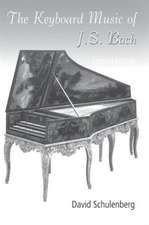Interpreting Mozart: The Performance of His Piano Pieces and Other Compositions
Autor Eva Badura-Skoda, Paul Badura-Skodaen Limba Engleză Paperback – 8 iun 2010
| Toate formatele și edițiile | Preț | Express |
|---|---|---|
| Paperback (1) | 422.47 lei 3-5 săpt. | +36.25 lei 4-10 zile |
| Taylor & Francis – 8 iun 2010 | 422.47 lei 3-5 săpt. | +36.25 lei 4-10 zile |
| Hardback (1) | 1021.73 lei 6-8 săpt. | |
| Taylor & Francis – 19 mai 2008 | 1021.73 lei 6-8 săpt. |
Preț: 422.47 lei
Preț vechi: 459.21 lei
-8% Nou
Puncte Express: 634
Preț estimativ în valută:
80.84€ • 84.62$ • 67.28£
80.84€ • 84.62$ • 67.28£
Carte disponibilă
Livrare economică 11-25 martie
Livrare express 22-28 februarie pentru 46.24 lei
Preluare comenzi: 021 569.72.76
Specificații
ISBN-13: 9780415977517
ISBN-10: 0415977517
Pagini: 496
Ilustrații: 1200 black & white line drawings
Dimensiuni: 178 x 254 x 25 mm
Greutate: 0.89 kg
Ediția:Revizuită
Editura: Taylor & Francis
Colecția Routledge
Locul publicării:Oxford, United Kingdom
ISBN-10: 0415977517
Pagini: 496
Ilustrații: 1200 black & white line drawings
Dimensiuni: 178 x 254 x 25 mm
Greutate: 0.89 kg
Ediția:Revizuită
Editura: Taylor & Francis
Colecția Routledge
Locul publicării:Oxford, United Kingdom
Cuprins
Introduction 1. Mozart's World of Sound 2. Dynamics 3. Problems of Tempo and Rhythm 4. Articulation 5. Ornaments 6. Improvised Embellishments 7. Cadenzas and Lead-Ins 8. "Expression und Gusto" 9. In Search of the Best Text 10. Playing with Orchestra 11. Some Technical Questions 12. Remarks on the Interpretation of Selected Piano Works Appendix 1: Reports about the proper Tempo of Pamina's Aria "Ach, ich fühl's…" Appendix 2: An Example of "Basso Continuo" playing in the Concerto K 414
Notă biografică
Paul Badura-Skoda is one of the most important pianists of our time. In 1945, Badura-Skoda entered the Vienna entered the Vienna Conservatory, and two years later won first prize in the Austrian Music Competition and a scholarship which allowed him to study with Edwin Fischer. In 1949, Wilhelm Firtwängler and Herbert von Karajan became aware of Badura-Skoda's outstanding talent, and invited him to play concerts. Practically overnight the young Viennese became a world-famous artist. Since then, Badura-Skoda has been a regular and celebrated guest at the most important music festivals, and a soloist with world's most prestigious orchestras.
Eva Badura-Skoda is a musicologist, publishing extensively on the history of the piano and on performance-practice problems of the 18th and 19th centuries.
Eva Badura-Skoda is a musicologist, publishing extensively on the history of the piano and on performance-practice problems of the 18th and 19th centuries.
Descriere
Paul Badura-Skoda is considered to be one of the great pianists of his generation, as well as an important scholar who has created definitive editions of many of the works of the Viennese masters, most notably Wolfgang Amadeus Mozart. With his wife, the noted musicologist Eva Badura-Skoda, he wrote the highly influential Interpreting Mozart on the Keyboard, first published in German in 1957, then in English and Japanese in 1962 and 1963, respectively. Long out of print, this important work has never been updated to reflect the last half-century of scholarship on Mozart’s music. Now, the husband-and-wife team have tackled this project, producing an entirely new text that will serve students and scholars of keyboard literature and of the great composer.
The book begins by addressing the problems associated with performing Mozart’s piano music on "modern" instruments. It then moves through each element of performance—from dynamics to tempo and rhythm, articulation, ornamentation, embellishments, and cadenzas. Badura-Skoda is particularly well-known for his personal approach to performing these works, and his notes on how he both tries to rigorously recreate the composer’s intentions while still inserting his own personality into each performance will be of great interest to students of the piano repertory. The book then addresses problems of "text" (scholarship on Mozart’s scores), technical questions related to the piano itself, and how to play "continuo" (accompaniments that are indicated only by skeletal notation in the original scores). Finally, in an entirely new section, the pianist discusses four key works by Mozart, showing how the analysis of the book can be applied to practical examples.
Interpreting Mozart on the Keyboard takes a classic work and brings it freshly up to date. It will stand as the definitive statement from a master pianist.
The book begins by addressing the problems associated with performing Mozart’s piano music on "modern" instruments. It then moves through each element of performance—from dynamics to tempo and rhythm, articulation, ornamentation, embellishments, and cadenzas. Badura-Skoda is particularly well-known for his personal approach to performing these works, and his notes on how he both tries to rigorously recreate the composer’s intentions while still inserting his own personality into each performance will be of great interest to students of the piano repertory. The book then addresses problems of "text" (scholarship on Mozart’s scores), technical questions related to the piano itself, and how to play "continuo" (accompaniments that are indicated only by skeletal notation in the original scores). Finally, in an entirely new section, the pianist discusses four key works by Mozart, showing how the analysis of the book can be applied to practical examples.
Interpreting Mozart on the Keyboard takes a classic work and brings it freshly up to date. It will stand as the definitive statement from a master pianist.

















